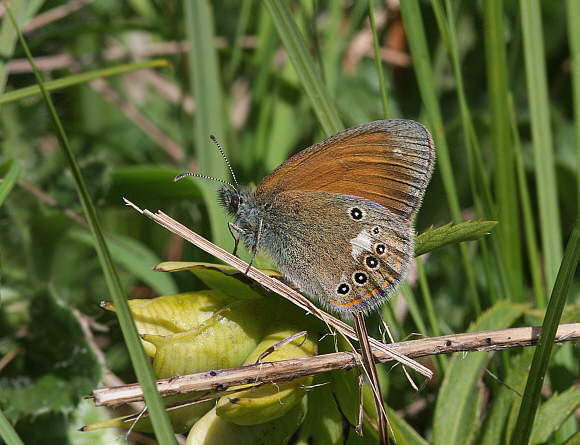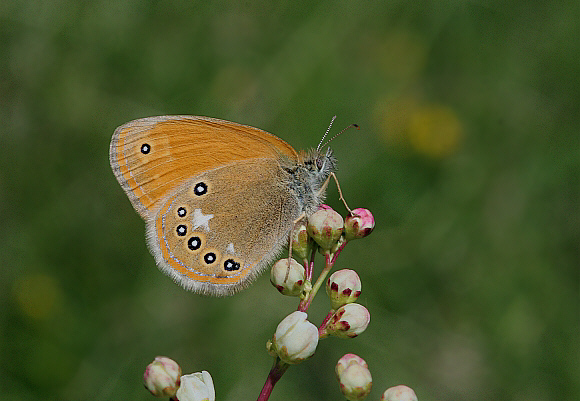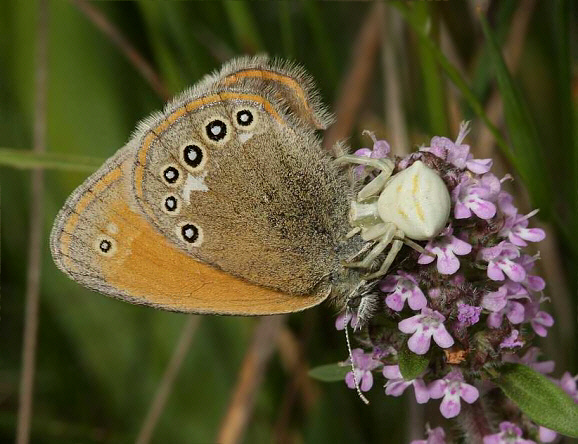 Coenonympha glycerion, Jadovno, Velebit mountains, Croatia – Peter Bruce-Jones
Coenonympha glycerion, Jadovno, Velebit mountains, Croatia – Peter Bruce-Jones
Introduction
The genus Coenonympha comprises 39 known species, found variously in North America, Europe, north Africa and temperate areas of Asia. There are 14 species in Europe.
Coenonympha glycerion is found across much of Europe from northern Portugal to Russia, but is absent from many areas including Britain, Sweden, Norway, Finland, southern Spain and western France. Beyond Europe it’s range extends to Siberia, Mongolia and Japan.
The size and number of ocelli on the underside wings varies considerably according to locality. In the Spanish subspecies C. glycerion iphioides they are particularly prominent. In examples from cooler areas the ocelli are often entirely absent. The white markings on the hindwings also vary greatly, some examples having just one or two small white patches, while in others these are linked to form a prominent white post-median band.
 Coenonympha glycerion, Jadovno, Velebit mountains, Croatia – Peter Bruce-Jones
Coenonympha glycerion, Jadovno, Velebit mountains, Croatia – Peter Bruce-Jones
Habitats
Coenonympha glycerion is found in sheltered grassy habitats including sub-alpine hay meadows, woodland clearings and scrubby grassland, at elevations between about 300-1800 metres.
Lifecycle
The butterflies emerge from early June to late August according to locality and lay their eggs singly on grass blades, usually close to bushes.
The caterpillar when fully grown is pale green, with a prominent white stripe below the spiracles, and a series of thin faint whitish stripes along the back. It feeds nocturnally on grasses including Brachypodium sylvaticum, Cynosurus cristatus, Briza media, Melica ciliata and Bromus erectus.
The chrysalis is of the usual Satyrine shape, pale green in colour, with a peppering of tiny white dots. The inner margins of the wing cases are white, edged with black. It is suspended by the cremaster from a stem or leaf.
Adult behaviour
Both sexes commonly nectar at a wide range of flowers including ox-eye daisy, heather, scabious, thyme, vetches and umbellifers.
The butterflies are active on warm sunny days but tend to hide among bushes in hot weather. On overcast days, and when roosting overnight, they usually sit at the top of dead flower heads, most commonly on plantains.
 Coenonympha glycerion ambushed by crab spider Thomisus onustus – Peter Bruce-Jones
Coenonympha glycerion ambushed by crab spider Thomisus onustus – Peter Bruce-Jones
The butterfly depicted above has been ambushed by a crab spider Thomisus onustus ( Thomisidae ). This remarkable spider has a chameleon-like ability to change colour to match it’s surroundings, so it can be white, yellow, pink or variegated in appearance. The change of colour takes about 2 or 3 days to complete however, so it is common to find a spider on the “wrong colour” of flower.
Crab spiders often spend several days motionless on a flower head, waiting for their next meal to fly in. They have excellent forward vision, and move immediately and stealthily towards any bee or butterfly which settles on the flower. In contrast, their peripheral vision is poor, so much so that it is possible for a butterfly to settle alongside the spider without being attacked. If on the other hand it is unfortunate enough to walk across the spider’s field of vision, the powerful pincer-like forelegs immediately seize the butterfly. The spider then bites it on the neck, injecting it with a paralysing venom which incorporates enzymes that liquefy the butterfly’s internal tissues. Thomisus onustus then sucks out the body contents of the butterfly, discarding the chitinous exoskeleton and wings.
